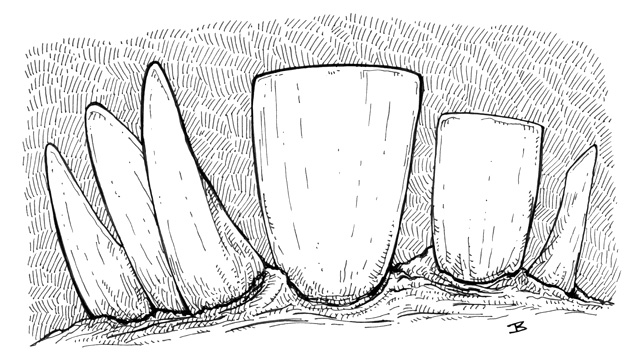This week's monster may perhaps make an interesting addition to a cave or tunnel entrance...
TITANS' TEETH
FREQUENCY: Very Rare
NO. APPEARING: 4-16
ARMOR CLASS: 5
MOVE: 1/8"
HIT DICE: 1
% IN LAIR: Nil
TREASURE TYPE: Nil
NO. OF ATTACKS: 0
DAMAGE/ATTACK: Nil
SPECIAL ATTACKS: Nil
SPECIAL DEFENSES: See below
MAGIC RESISTANCE: Standard
INTELLIGENCE: Non-
ALIGNMENT: Neutral
SIZE: S to M
PSIONIC ABILITY: Nil
Attack/Defense Modes: Nil
Titans' Teeth are a fungus most often found growing in rocky places, stone ruins, caves and tunnels. Certain rumours state that they can also be found on old battlefields and other places of conflict, and will slowly make their way toward any decaying flesh. Their outer shell is quite tough and a great deal of work is needed to break one apart. When this happens, there is a 30% possibility that any exposed skin will be pierced by tiny shell fragments, although this will cause no immediate sensation of pain or discomfort. If this occurs, the skin will start to erupt in 1-4 hours with small, tooth-like growths that will cause a great deal of maddeningly painful itching. Only Cure Light Wounds will rid the victim of such growths which, if left to grow, will slowly and painfully consume the victim in 8-64 days. The main reason that any creatures make such an effort to break Titans' Teeth is because of the spongy, bread-like matter that makes up the core of each growth. This has a pleasant sweet taste and is very nutritious, a pound of which is equivalent to 2 day's good rations. A single 'tooth' will contain 1-8 pounds of such matter.
Description: Titans' Teeth grow in curved rows, and look exactly like a set of human incisors and canines, although much larger in size (at least 2' tall). If found in caves, tunnels, or similar environments it is possible to find a set growing down from above as well as from below. Their outer shell is pearlescent white and smooth, whilst inside they are a dark yellowish-green. They have a somewhat fibrous root system, which is deep red in colour.
Next week: the Witches' Nest...




